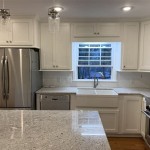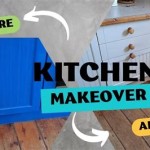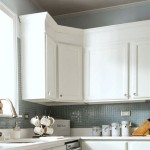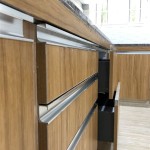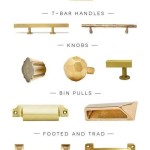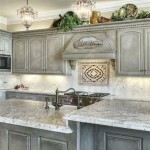Modern Painted Kitchen Cabinets: A Comprehensive Guide
Modern painted kitchen cabinets represent a popular and versatile choice for homeowners seeking to update or remodel their kitchen spaces. The application of paint offers a broad spectrum of stylistic possibilities, allowing for customization and personalization to align with diverse design preferences and architectural forms. This article provides a comprehensive overview of modern painted kitchen cabinets, encompassing material considerations, painting techniques, color selection, hardware integration, and maintenance essentials.
Material Selection for Painted Kitchen Cabinets
The underlying substrate of a kitchen cabinet significantly impacts the durability and visual appeal of a painted finish. Several materials are commonly employed in cabinet construction, each possessing unique characteristics that influence paint adhesion, structural integrity, and overall lifespan.
Solid Wood: Solid wood, such as maple, birch, or oak, provides a robust and stable foundation for painted cabinets. Maple is frequently favored due to its tight grain and smooth surface, which facilitate optimal paint adhesion and minimize the visibility of wood grain through the paint layer. Oak, while durable, possesses a more pronounced grain pattern that may require additional preparation to achieve a smooth, uniform finish. Solid wood cabinets are typically more expensive than alternative options, but they offer superior longevity and can be refinished multiple times.
Medium-Density Fiberboard (MDF): MDF is an engineered wood product composed of fine wood fibers bonded together under high pressure. It offers a consistent, smooth surface that is ideal for painting, as it lacks the grain variations and knots inherent in solid wood. MDF is less susceptible to warping or cracking than solid wood, making it a suitable choice for humid environments. However, MDF is more vulnerable to water damage and impact than solid wood, necessitating careful handling and installation. It is generally a more cost-effective option than solid wood.
Plywood: Plywood consists of thin layers of wood veneer glued together, creating a strong and stable composite material. High-quality plywood can provide a good substrate for painting, offering a balance between durability and cost. However, the edges of plywood may require additional preparation to ensure a smooth, paintable surface. Lower-grade plywood may exhibit imperfections or voids that can compromise the quality of the painted finish. Selecting plywood with a smooth veneer face is crucial for achieving optimal results.
Thermofoil: While not directly painted, thermofoil is a vinyl laminate applied to an MDF core. It mimics the appearance of painted cabinets and offers a durable, easy-to-clean surface. However, thermofoil can be susceptible to peeling or delamination in high-heat or high-humidity environments, and it is difficult to repair. While some may consider thermofoil cabinets to be "painted," they lack the traditional layered paint application and generally have limited customization options.
Painting Techniques and Surface Preparation
Achieving a professional-quality painted finish on kitchen cabinets requires meticulous surface preparation and the application of appropriate painting techniques. The following steps are essential for ensuring a durable and visually appealing result.
Cleaning and Degreasing: Prior to painting, cabinets must be thoroughly cleaned to remove any dirt, grease, or contaminants that could impede paint adhesion. A mild detergent solution, followed by a clean water rinse, is typically sufficient for cleaning. For heavily soiled surfaces, a degreasing agent may be necessary. Surfaces must be completely dry before proceeding.
Sanding: Sanding is a critical step in preparing the surface for painting. Sanding roughens the surface, creating a mechanical bond that enhances paint adhesion. The appropriate grit of sandpaper will depend on the substrate material and the existing finish. For previously painted cabinets, sanding with a fine-grit sandpaper (e.g., 220-grit) is recommended to create a smooth, uniform surface. New, unfinished cabinets may require more aggressive sanding to remove any imperfections or mill marks. Dust generated from sanding should be removed with a tack cloth.
Priming: Applying a primer is essential for promoting paint adhesion, sealing the surface, and creating a uniform base for the topcoat. The type of primer should be selected based on the substrate material and the type of paint being used. Oil-based primers are often preferred for solid wood cabinets, as they provide excellent sealing properties and block tannins that can bleed through the paint. Latex primers are suitable for MDF and plywood. Stain-blocking primers are recommended for cabinets with existing stains or finishes that may bleed through the paint. The primer should be applied in thin, even coats, allowing sufficient drying time between coats.
Painting: The application of paint can be accomplished using various methods, including brushing, rolling, and spraying. Spraying generally produces the smoothest, most uniform finish, but it requires specialized equipment and a well-ventilated workspace. Brushing and rolling are more accessible methods, but they may result in brushstrokes or roller stipple if not executed properly. Multiple thin coats of paint are preferable to a single thick coat, as they minimize the risk of drips, runs, and sagging. The type of paint should be chosen based on durability, ease of cleaning, and desired sheen. Acrylic latex paints are a popular choice for kitchen cabinets due to their durability, low VOC content, and wide range of color options. Oil-based paints offer excellent durability and a smooth, hard finish, but they have higher VOC content and require more extensive cleanup. Paints specifically formulated for cabinets and trim are recommended, as they offer superior adhesion and resistance to chipping and scratching.
Sealing (Optional): Applying a clear coat of sealant can provide an additional layer of protection against wear and tear, particularly in high-traffic areas such as around the sink or stove. Polyurethane sealants are a durable and water-resistant option. Sealants should be applied in thin, even coats, allowing sufficient drying time between coats.
Color Selection and Hardware Integration
The selection of paint colors and hardware significantly influences the overall aesthetic of modern painted kitchen cabinets. Consideration should be given to the existing décor, lighting conditions, and personal preferences when making these choices.
Color Palettes: Modern kitchen cabinet color palettes encompass a wide range of hues, from classic neutrals to bold, contemporary colors. White and off-white shades remain popular choices for their versatility and ability to create a bright, airy atmosphere. Gray is another versatile neutral that can be paired with a variety of accent colors. For a more contemporary look, consider using bolder colors such as navy blue, emerald green, or charcoal gray. Two-tone color schemes, where upper and lower cabinets are painted in different colors, are also a popular trend. The color of the walls, flooring, and countertops should be considered when selecting cabinet colors to ensure a cohesive design.
Sheen Levels: The sheen level of the paint affects the appearance and durability of the painted finish. Lower sheen levels, such as matte or eggshell, offer a softer, more subtle look and are less likely to show imperfections. However, they are also less durable and more difficult to clean. Higher sheen levels, such as semi-gloss or gloss, offer a more reflective and durable finish, but they are more likely to highlight imperfections. A satin or semi-gloss sheen is generally recommended for kitchen cabinets, as it provides a balance between durability and aesthetics.
Hardware Selection: The choice of hardware, including knobs, pulls, and hinges, can greatly enhance the style of modern painted kitchen cabinets. Sleek, minimalist hardware in brushed nickel or stainless steel is a popular choice for contemporary kitchens. For a more traditional look, consider using ornate hardware in antique brass or oil-rubbed bronze. The size and style of the hardware should be proportional to the size of the cabinet doors and drawers. Consider the functionality of the hardware as well, ensuring that it is comfortable to grip and easy to use. Concealed hinges provide a clean, seamless look, while exposed hinges can add a touch of character.
Lighting Considerations: The color of paint can appear different under different lighting conditions. Natural light tends to enhance the vibrancy of colors, while artificial light can alter their appearance. It is important to test paint samples in the kitchen under various lighting conditions to ensure that the chosen color is appealing in all environments. Under-cabinet lighting can also highlight the texture and color of the painted cabinets, creating a more dramatic effect.
Countertop and Backsplash Coordination: The color and material of the countertops and backsplash should complement the painted kitchen cabinets. For example, white cabinets pair well with granite countertops in a variety of colors, while dark cabinets can be paired with light-colored countertops to create contrast. The backsplash can be used to add a pop of color or texture to the kitchen. Consider using materials such as glass tile, ceramic tile, or natural stone for the backsplash.
Maintenance and Care for Painted Kitchen Cabinets
Proper maintenance and care are essential for preserving the beauty and extending the lifespan of modern painted kitchen cabinets. Regular cleaning and preventative measures can help protect the painted finish from damage and ensure that the cabinets continue to look their best.
Regular Cleaning: Painted kitchen cabinets should be cleaned regularly to remove dirt, grease, and spills. A mild detergent solution and a soft cloth are typically sufficient for cleaning. Avoid using abrasive cleaners or scouring pads, as they can damage the painted finish. Wipe up spills immediately to prevent staining. For stubborn stains, a paste of baking soda and water can be applied to the affected area and gently scrubbed with a soft cloth.
Preventative Measures: Several preventative measures can help protect painted kitchen cabinets from damage. Avoid placing hot items directly on the cabinets, as this can cause the paint to blister or peel. Use placemats and coasters to protect the cabinets from scratches and spills. Install bumpers on cabinet doors and drawers to prevent them from slamming shut. Clean the cabinets regularly to prevent the buildup of dirt and grease. Consider using a protective sealant on high-traffic areas to provide an additional layer of protection.
Touch-Up Painting: Over time, painted kitchen cabinets may develop chips or scratches. Touch-up painting can be used to repair minor damage and restore the appearance of the cabinets. Use a small brush and the same paint that was used to originally paint the cabinets. Apply thin coats of paint to the damaged area, allowing sufficient drying time between coats. Lightly sand the edges of the touched-up area to blend it with the surrounding paint. A clear coat of sealant can be applied to protect the touched-up area.
Humidity Control: Excessive humidity can damage painted kitchen cabinets, causing the paint to blister, peel, or crack. Ensure that the kitchen is properly ventilated to prevent the buildup of humidity. Use a dehumidifier if necessary to control the humidity level. Avoid placing cabinets near sources of moisture, such as the dishwasher or sink. Inspect the cabinets regularly for signs of water damage and address any issues promptly.
Hardware Maintenance: Regularly inspect the hardware on the kitchen cabinets to ensure that it is securely attached and functioning properly. Tighten any loose screws. Clean the hardware with a mild detergent solution and a soft cloth. Lubricate the hinges with a silicone-based lubricant to prevent squeaking. Replace any damaged or worn hardware.

Modern Kitchen Cabinets Colors Best Ideas For 2024

15 Best Painted Kitchen Cabinets Ideas For Transforming Your With Color

160 Kitchen Painted Cabinets Colour Ideas In 2024 Inspirations Remodel

Modern Style Kitchen Furniture Pvc Painting Cabinets China Cabinet Designs Made In Com

15 Best Painted Kitchen Cabinets Ideas For Transforming Your With Color

How To Paint Kitchen Cabinets Like The Pros

Painted Kitchen Cabinets Contemporary Minneapolis By Cliqstudios Houzz

Modern Kitchen Paint Ideas To Fulfill Your Dreams Paintzen

Kitchen Painting Projects Before And After Paper Moon

Cost To Paint Kitchen Cabinets 2024 Data Angi
Related Posts

